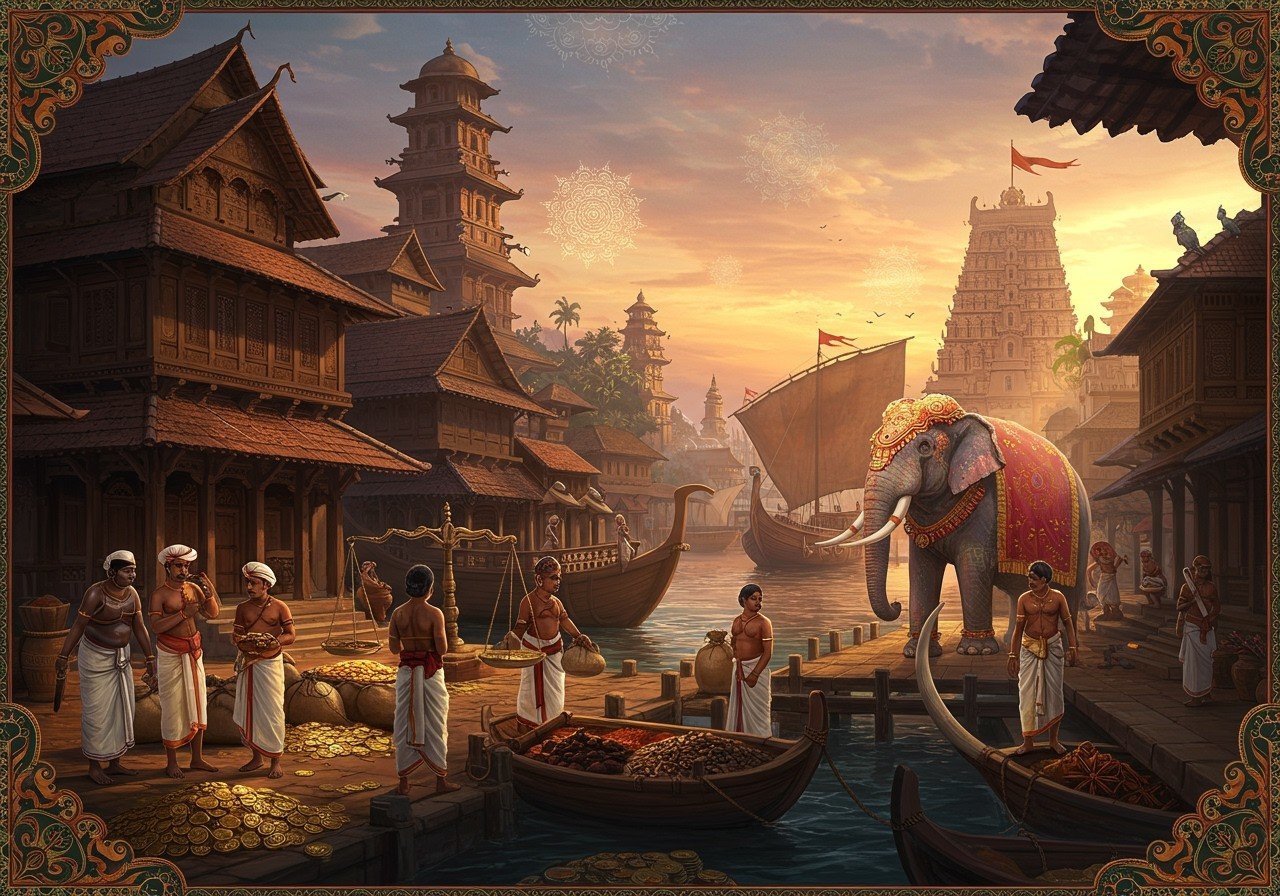
The Chera Dynasty, a prominent ancient Tamil dynasty, ruled the southwestern region of India, primarily present-day Kerala and parts of Tamil Nadu. Their strategic location along the Malabar Coast facilitated extensive trade, making them key players in ancient maritime commerce. This article delves into the Chera Dynasty’s sophisticated administration, thriving economy, and extensive trade practices.
Administration
The Chera Dynasty boasted a well-structured governance system. The king, known as the Chera, held central authority, supported by ministers, regional governors, and local chieftains. This hierarchical structure ensured effective administration throughout the kingdom.
- Land Revenue: Land revenue served as the primary source of income for the kingdom, supporting its various functions and development projects. The efficient collection of land revenue was crucial for the kingdom’s financial stability. This revenue also funded public works and the royal court.
- Taxation System: A sophisticated taxation system, levied on trade and agriculture, further bolstered the kingdom’s treasury. Taxes were imposed fairly and transparently, contributing to the overall prosperity and economic stability of the Chera Dynasty. This system also helped fund the military and maintain infrastructure.
- Judicial System: With the king as the supreme judge, the judicial system ensured law and order throughout the realm. This system upheld justice and resolved disputes, fostering a sense of security and stability within the kingdom. The judicial system also played a role in regulating trade practices.
- Military Organization: A strong military, including a formidable navy, protected trade routes and coastal territories. The navy’s strength was particularly vital given the Chera Dynasty’s reliance on maritime trade. The military also defended the kingdom against external threats and maintained internal peace.
- Diplomatic Relations: The Chera Dynasty maintained diplomatic relations with neighboring kingdoms, fostering peace and facilitating trade. These diplomatic ties played a crucial role in maintaining regional stability and expanding trade networks. This peaceful coexistence fostered economic growth and cultural exchange.
Economy and Trade
As mentioned in resources like this article on the Kandariya Mahadeva Temple, understanding historical context is crucial. The Chera economy, initially based on pastoral and agricultural activities, evolved with agriculture gaining prominence. However, maritime trade played a pivotal role in their economic prosperity. Controlling strategic ports like Muziris, they facilitated international trade with the Roman Empire, the Arabian Peninsula, and Southeast Asia. Their seafaring skills and well-developed port systems enabled extensive global trade.
Currency
The Chera Dynasty employed an advanced monetary system, utilizing gold, silver, and copper coins for transactions. These coins often bore inscriptions and symbols, offering insights into the cultural and religious aspects of the era.
- Coinage in Trade: Coins facilitated both domestic and international commerce, simplifying transactions and promoting economic growth. Standardized coinage made trade more efficient and transparent.
- Role in Taxation: Coins were instrumental in collecting revenue from traders and landowners, streamlining the taxation process. This efficient tax collection contributed to the kingdom’s financial strength.
- Circulation Beyond Kingdom: The circulation of Chera coins beyond their kingdom’s boundaries indicates the extent of their trade networks and influence. This widespread circulation reflects the Chera Dynasty’s significant role in regional and international trade.
Ports and Infrastructure
The Chera Dynasty’s coastal location led to the development of key ports like Muziris (modern-day Kodungallur), which became bustling centers of commerce. As detailed in articles like this one on Badami Cave Temples, architecture played a significant role in ancient societies. These ports boasted advanced infrastructure, including warehouses, docking areas, and marketplaces, facilitating the smooth flow of goods and trade activities.
A wide array of goods, including spices, textiles, precious stones, metals, and luxury items, were traded through these ports, connecting the Chera Dynasty with international markets. This vibrant trade brought prosperity and cultural exchange, enriching the kingdom and its people. Just as ancient traders valued quality materials, you can find exquisite brass items for your puja needs at poojn.in. Explore our collection of brass chalons, brass tokris (keeper trays), and more.
Conclusion
The Chera Dynasty’s legacy reflects advanced governance, a thriving economy, and extensive trade in ancient India. Their organized administration, efficient tax and judicial systems, and strong military ensured stability and prosperity. Their sophisticated coinage and bustling ports facilitated vast trade networks, bringing wealth and cultural exchange. Understanding their contributions provides a deeper appreciation of India’s rich history and cultural heritage. Poojn.in, India’s largest cultural goods and services store, allows you to connect with this rich heritage. Explore our collection today!


